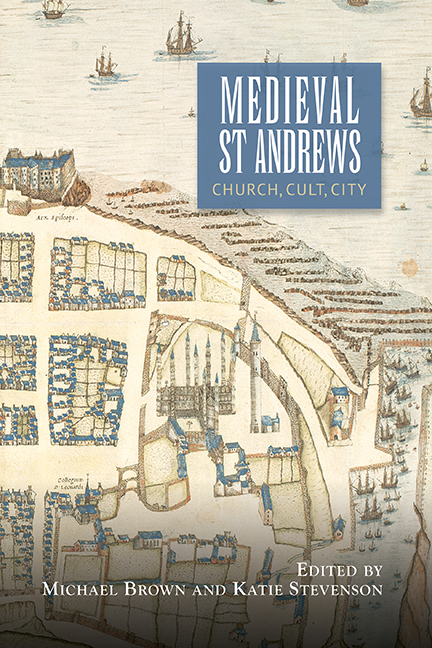Book contents
- Frontmatter
- Dedication
- Contents
- List of Illustrations, Charts and Tables
- Contributors
- Abbreviations
- 1 ‘Ancient Magnificence’: St Andrews in the Middle Ages: An Introduction
- 2 From Cinrigh Monai to Civitas Sancti Andree: A Star is Born
- 3 The Idea of St Andrews as the Second Rome Made Manifest
- 4 The Medieval Ecclesiastical Architecture of St Andrews as a Channel for the Introduction of New Ideas
- 5 When the Miracles Ceased: Shrine and Cult Management at St Andrews and Scottish Cathedrals in the Later Middle Ages
- 6 Religion, Ritual and the Rhythm of the Year in Later Medieval St Andrews
- 7 Living in the Late Medieval Town of St Andrews
- 8 The Burgh of St Andrews and its Inhabitants before the Wars of Independence
- 9 The Archaeology of Medieval St Andrews
- 10 Prelates, Citizens and Landed Folk: St Andrews as a Centre of Lordship in the Late Middle Ages
- 11 Augmenting Rentals: The Expansion of Church Property in St Andrews, c. 1400–1560
- 12 The Prehistory of the University of St Andrews
- 13 University, City and Society
- 14 The Medieval Maces of the University of St Andrews
- 15 Heresy, Inquisition and Late Medieval St Andrews
- Appendix 1 The St Andrews Foundation Account
- Appendix 2 The Augustinian' Account
- Appendix 3 The Boar' Raik
- Appendix 4 University of St Andrews Library, UYSL 110/6/4
- Index
- Miscellaneous Endmatter
2 - From Cinrigh Monai to Civitas Sancti Andree: A Star is Born
Published online by Cambridge University Press: 28 April 2017
- Frontmatter
- Dedication
- Contents
- List of Illustrations, Charts and Tables
- Contributors
- Abbreviations
- 1 ‘Ancient Magnificence’: St Andrews in the Middle Ages: An Introduction
- 2 From Cinrigh Monai to Civitas Sancti Andree: A Star is Born
- 3 The Idea of St Andrews as the Second Rome Made Manifest
- 4 The Medieval Ecclesiastical Architecture of St Andrews as a Channel for the Introduction of New Ideas
- 5 When the Miracles Ceased: Shrine and Cult Management at St Andrews and Scottish Cathedrals in the Later Middle Ages
- 6 Religion, Ritual and the Rhythm of the Year in Later Medieval St Andrews
- 7 Living in the Late Medieval Town of St Andrews
- 8 The Burgh of St Andrews and its Inhabitants before the Wars of Independence
- 9 The Archaeology of Medieval St Andrews
- 10 Prelates, Citizens and Landed Folk: St Andrews as a Centre of Lordship in the Late Middle Ages
- 11 Augmenting Rentals: The Expansion of Church Property in St Andrews, c. 1400–1560
- 12 The Prehistory of the University of St Andrews
- 13 University, City and Society
- 14 The Medieval Maces of the University of St Andrews
- 15 Heresy, Inquisition and Late Medieval St Andrews
- Appendix 1 The St Andrews Foundation Account
- Appendix 2 The Augustinian' Account
- Appendix 3 The Boar' Raik
- Appendix 4 University of St Andrews Library, UYSL 110/6/4
- Index
- Miscellaneous Endmatter
Summary
THIS chapter has as its focus the earliest written material concerning the place now known as St Andrews, from the mid eighth century to the end of the twelfth. Because of the nature both of the sources and the place, this material is overwhelmingly ecclesiastical in context and content. However, the Christian, ecclesiastical story of St Andrews begins already in the pre-documentary, archaeological record. Excavations have revealed early Christian long cist cemeteries both beside St Mary's Collegiate Church on the headland above the harbour (at Kirkheugh) and at Hallow Hill, a low hill bounded on three sides by burns, the Kinness Burn on the north and the Cairnsmill Burn on the west and south-west, just over 2km south-west of the St Andrews cathedral complex. The earliest documentary reference to the place now known as St Andrews comes in 747 when ‘the death of Tuathalán abbot of Kinrymont’ is recorded in the Annals of Ulster. Already by this time the place must have been of more than local importance, since this reference occurs in a source probably written in Brega (east central Ireland) and is a rare instance of interest shown by these annals in a Pictish religious house. The St Andrews sarcophagus, one of the finest pieces of early medieval sculpture from northern Europe, discovered in 1833 at the heart of the early church precinct, probably dates to only a short time after this annal reference and is further proof of the very high status of the place in this period.
There are no secure references to Kinrymont for the ninth century, although the fifteenth-century historians Andrew Wyntoun and Walter Bower, both following an account (now lost) drawn up at an earlier date at St Andrews, name Cellach as the first bishop of St Andrews and state that he held this office from the time of King Giric (878–89). A more secure reference to a Bishop Cellach concerns the year 906, when he presided with Constantine son of Aodh (Cústantin mac Aeda) over an assembly in Scone. It is probably correct to assume that Cellach was based at St Andrews, although, as with other later and better-attested bishops of St Andrews who are styled variously bishop of Alba or bishop of the Scots, his office had national rather than merely local diocesan significance.
- Type
- Chapter
- Information
- Medieval St AndrewsChurch, Cult, City, pp. 20 - 34Publisher: Boydell & BrewerPrint publication year: 2017



